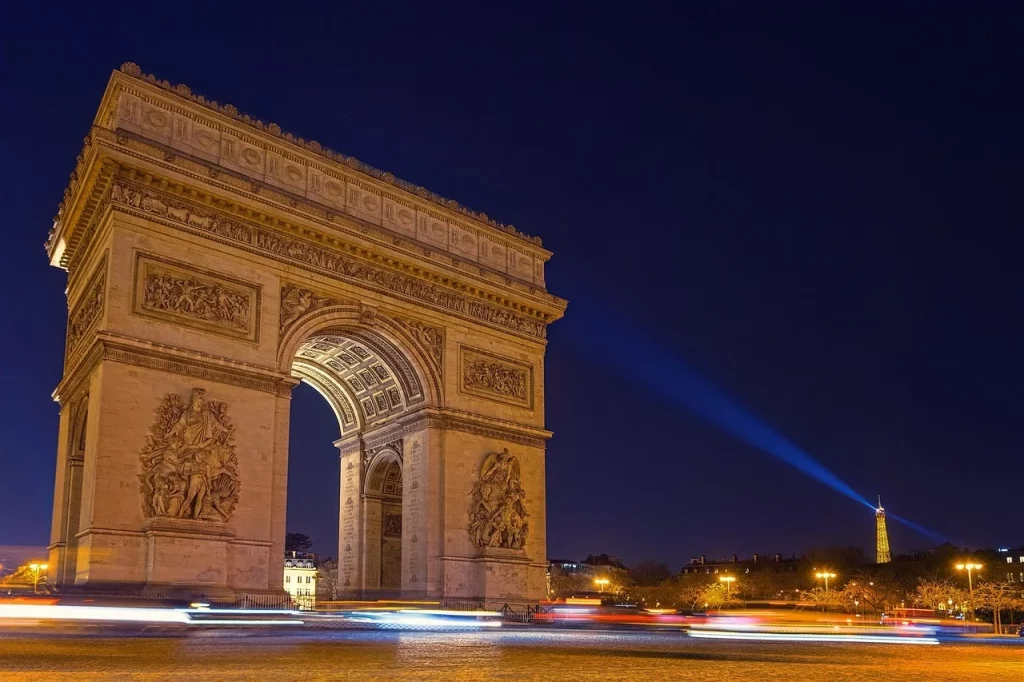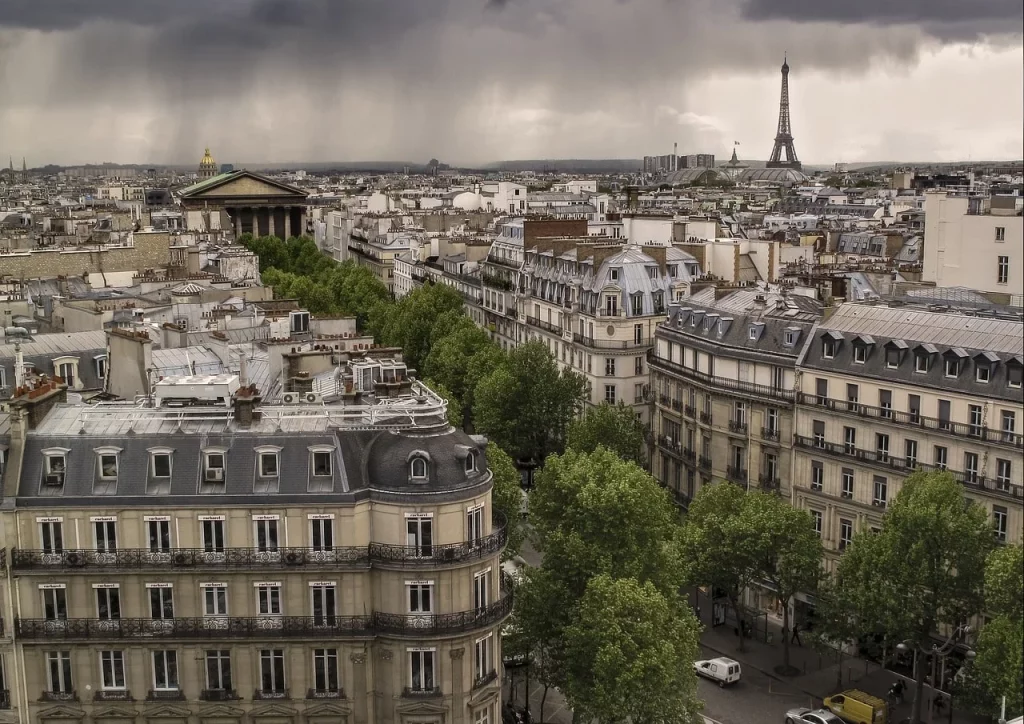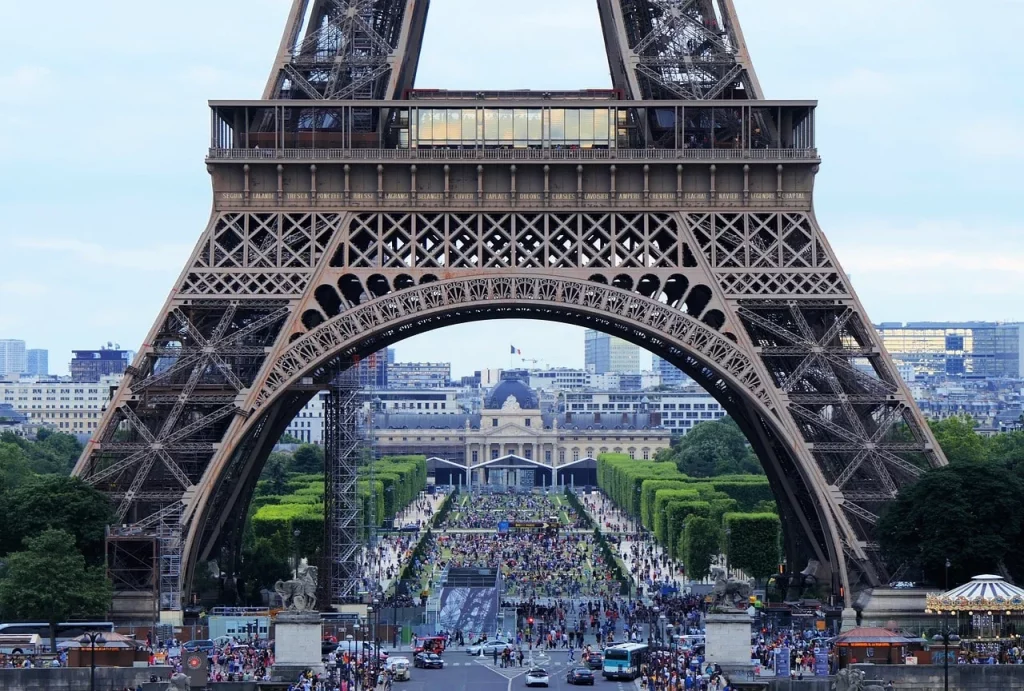Paris captivates the heart of every traveler with its unparalleled charm, art, and history. But how well do you really know this iconic city? Beyond the glamour of its landmarks lies a treasure trove of secrets waiting to be uncovered.
In this article, we’re exploring some astonishing facts about Paris, from its ancient underground passageways to the whispers of its past inhabitants. Prepare to be enchanted by the stories that make Paris the timeless city of dreams.
Paris is always a good idea.
Audrey Hepburn
Paris Facts
Get ready to immerse yourself in the world of Paris, where every fact is a doorway to its soul. Read carefully because I created a quiz at the article’s end to test your expertise on the city of lights.
- The name “City of Lights” is attributed to Paris not just for its illuminated boulevards but also because it was a beacon of enlightenment and learning during the Enlightenment era.
- Constructed as a temporary installment for the 1889 World Fair, the Eiffel Tower nearly faced demolition but has become Paris’s quintessential symbol.
- Home to the renowned Mona Lisa, the Louvre Museum stands as the premier museum for art globally, boasting an unparalleled collection of artistic works.
- The Pont Neuf, despite what its name suggests as ‘New Bridge’, is the eldest bridge in Paris, completed in the year 1607.
- Opening its gates in 1900, the Paris Métro ranks among the world’s earliest underground rail systems.
- Montmartre, situated atop Paris’s highest hill, is celebrated for its artistic heritage and was once a gathering spot for artists such as Picasso and Van Gogh.
- Lutetia, the Roman predecessor of Paris, was established in the 3rd century BC, marking the city’s ancient origins.
- The start of the French Revolution in 1789 in Paris marked a turning point in French and global history, originating from this historic city.
- A smaller counterpart to New York’s Statue of Liberty, Paris’s own Statue of Liberty was a gift from the United States, commemorating the year 1889.
- Paris is systematically organized into 20 districts, or arrondissements, that spiral outward in a snail-shell pattern from its core.
- The Catacombs of Paris serve as the final resting place for over 6 million individuals, a relocation effort from the 18th century to solve cemetery overcrowding.
- Notre-Dame de Paris, one of the city’s most venerable and iconic cathedrals, saw its foundation laid in 1163, with completion nearly two centuries afterward.
- Known today as Place de la Concorde, this central square was once termed Place Louis XV before being renamed following the French Revolution.

- Held biannually, Paris Fashion Week is a pivotal event in the global fashion calendar, drawing attention from across the fashion industry.
- Despite its urban landscape, Paris is surprisingly one of the most verdant capitals in Europe, with over 400 parks and gardens scattered throughout the city.
- The Bibliothèque Nationale de France, dating back to the 14th century, is among the oldest and largest libraries on a global scale.
- The completion of the Montparnasse Tower in 1973 led to public outcry over its modern design amidst Paris’s historic vistas, prompting height restrictions on future buildings.
- Crossing through Paris, the Seine River is adorned with 37 bridges within the city limits, playing a crucial role in its historical and cultural fabric.
- Known for its preserved pre-revolutionary architecture and dynamic LGBTQ+ scene, Le Marais stands out as one of Paris’s most historic neighborhoods.
- With its contemporary skyscrapers, La Défense showcases a modern contrast to Paris’s traditional architectural heritage.
- Historically, Paris was encircled by a massive stone fortification, parts of which are still visible today.
- The Galeries Lafayette, aside from its luxury retail offerings, is celebrated for its exquisite Belle Époque architecture.
- Since its establishment in 1257, Sorbonne University has been a bastion of education and intellectual pursuit in Paris.
- Just outside Paris, the Palace of Versailles stands as a testament to the absolute monarchy of the Ancien Régime, serving as the royal residence until the revolution.
- The bustling Gare du Nord station is the busiest in Europe, serving as a critical gateway for travelers to and from Paris.
- Originating in Parisian cuisine, the famed dessert Crème brûlée remains a staple in the city’s culinary offerings.
- Renowned for its exceptional interior and acoustics, the Paris Opera is an architectural gem from the 19th century.
- Established in 1626 as the king’s medicinal herb garden, the Jardin des Plantes is Paris’s primary botanical garden.

- The Latin Quarter is acclaimed for its vibrant student life, historic cafes, and as the intellectual core of Paris.
- Paris’s storied streets and landmarks have served as the setting for countless classic films, enhancing its stature as a cultural icon globally.
- Admired for its scenic bridges and walkways, the Canal Saint-Martin is a favored locale among both Parisians and visitors.
- The Île Saint-Louis and Île de la Cité are the historical heart of Paris, situated naturally in the Seine River.
- Paris’s gastronomic scene is unparalleled, boasting the highest number of Michelin-starred establishments in Europe.
- The Père Lachaise Cemetery is the burial site of numerous luminaries, such as Jim Morrison, Oscar Wilde, and Edith Piaf, among others.
- Described as the globe’s most splendid avenue, the Champs-Élysées extends from Place de la Concorde to the Arc de Triomphe.
- Constructed for the Universal Exposition of 1900, the Grand Palais and Petit Palais were intended to display France’s cultural and artistic prowess to the world.
- From 1940 to 1944, Paris experienced German occupation during World War II, a period that left a lasting imprint on its history and cultural identity.
- Inspired by Florence’s Boboli Gardens, the Luxembourg Gardens were conceived in 1612, offering serene green space in the city’s heart.

- The tradition of attaching Love Locks on Parisian bridges has been discouraged to protect the structures from damage.
- Opening in 1889, the Moulin Rouge cabaret is celebrated as the origin of the modern can-can dance.
- Commissioned by King Louis IX, Paris’s Sainte-Chapelle is famed for its breathtaking stained glass windows, designed to house sacred Christian relics.
- Founded in Paris in 1895, Le Cordon Bleu remains a prestigious institution for culinary and hospitality education, attracting students globally.
- Under Napoleon III’s Second Empire, Paris underwent significant urban transformation, introducing broad avenues, parks, and a modernized sewer system that define the city to this day.
- A city of hidden gems, Paris boasts numerous secluded courtyards and passageways, offering tranquil respites from its bustling avenues.
- The Philharmonie de Paris, unveiled in 2015, is lauded for its avant-garde design and superior acoustics, marking a new era in the city’s musical landscape.
- Contrasting with its historical facade, Paris nurtures a vibrant technology startup scene, often dubbed the “Silicon Sentier”.
- Established in 1628, the Marché des Enfants Rouges stands as Paris’s oldest covered market, offering a diverse array of fresh produce and flowers.
- The Wall of Love, located in the Montmartre district, features the phrase “I love you” written over 300 times in 250 languages, celebrating the universal nature of love.
- Paris hosts the largest Wholesale Food Market in the world at Rungis, spanning over 232 hectares and supplying a significant portion of Europe’s fresh food.
- The Paris Sewer Museum offers an unusual glimpse into the city’s underbelly, showcasing the history and engineering of Paris’s complex sewer network, a testament to modern urban planning.
Paris Myths

Having journeyed through the captivating facts of Paris, we now stand at the threshold of myth and reality. Let’s see the actual truth behind some common myths.
- The City of Light Is Always Romantic
Paris is often idolized as the pinnacle of romance, but the reality can be quite different. Crowds, noise, and urban challenges are part of the daily fabric. Romance is found in moments rather than pervasive in the air, often requiring intentional planning to experience those picturesque scenes. - French Baguettes Are Eaten with Every Meal
While baguettes are a staple in French cuisine, they are not consumed with every meal as often believed. The diversity of French cuisine means that many meals are enjoyed without the accompaniment of a baguette, though they remain a popular choice for sandwiches and as a side. - Parisians Are Rude to Tourists
This myth stems from cultural misunderstandings and language barriers. In fact, many Parisians are proud of their city and willing to help visitors. Politeness and a basic attempt at French can go a long way toward receiving a warm response from the locals. - The Eiffel Tower Can Be Seen from All Over Paris
Despite its iconic status, the Eiffel Tower isn’t visible from every part of Paris due to the city’s historic buildings and narrow streets. There are specific spots and elevated areas where it makes a grand appearance, but it’s not omnipresent. - Paris Is Expensive to Visit
Paris can be expensive, but like any major city, it offers a range of options to suit different budgets. Free museums, affordable dining options, and public transport can make a visit more accessible. Expenses are often influenced by choices rather than a fixed standard.
No products found.
Paris Quotes

The city of lights is a place full of inspiration. Below you will find some of my favorite quotes. Feel free to share yours in the comments so I can add them to the list.
A walk about Paris will provide lessons in history, beauty, and in the point of life.
Thomas Jefferson
Thomas Jefferson, the third President of the United States, reflects on how strolling through Paris offers profound insights into history, beauty, and life’s purpose.
Paris is not a city; it’s a world.
King Francis I
King Francis I of France emphasizes the vast cultural richness and diversity of Paris, likening it to a world unto itself.
If you are lucky enough to have lived in Paris as a young man, then wherever you go for the rest of your life, it stays with you, for Paris is a movable feast.
Ernest Hemingway
Ernest Hemingway, the renowned author, speaks to the indelible impact Paris has on young men, suggesting that the experiences there enrich one’s life forever.
Paris was a universe whole and entire unto herself, hollowed and fashioned by history.
Anne Rice
Anne Rice, the celebrated author, describes Paris as a self-contained universe, shaped and defined by its rich history.
To know Paris is to know a great deal.
Henry Miller
Henry Miller, the American writer, acknowledges the depth of knowledge and understanding one gains from experiencing Paris.
Paris FAQ

We are getting closer to the end, but before that, let’s read the answers to some popular questions. Read carefully to master the quiz ahead. Don’t disappoint me.
- What is Paris famous for?
Paris, known as “The City of Light,” is celebrated for the Eiffel Tower, its historic museums like the Louvre, and its role as a fashion and culinary capital. It embodies romance, offering a blend of beautiful architecture, art, and charming cafes that captivate visitors from around the globe. - Which Paris airport to fly into?
Paris has three main airports: Charles de Gaulle (CDG), Orly (ORY), and Beauvais-Tillé (BVA). CDG is the largest, handling international flights; ORY serves a mix of domestic and European flights; and BVA caters to low-cost airlines. Choose based on your destination, preferred airline, and budget. - How do you get around in Paris?
Paris’s public transport system includes the Métro, buses, and trams, making it easy to get around. For a closer look at the city, walking or biking is highly recommended. Taxis and rideshare services are also readily available for convenience. - What are the must-visit attractions in Paris?
Besides the Eiffel Tower and Louvre, must-visits include the Notre-Dame Cathedral, Montmartre and the Sacré-Cœur Basilica, and the Champs-Élysées leading to the Arc de Triomphe. A Seine River cruise offers a unique view of these and other landmarks. - What are the best times to visit Paris?
The best times are spring (March to May) and fall (September to November) for mild weather and fewer tourists. Summer (June to August) is warmer and busier, making it ideal for festivals. Winter (December to February) offers festive holiday decorations and markets with a cooler atmosphere.
No products found.
Paris Trivia

Welcome to our Paris quiz! Get ready to strut down the sea of knowledge. But beware; score zero, and you’ll find your next croissant mysteriously filled with escargot!
Conclusion
We’ve seen Paris as a paradox, a city deeply rooted in its rich history yet always on the cusp of the next trend. It’s a place where ancient stones whisper to modern hearts, inviting us into a dance that spans centuries.
Paris encourages us to look beyond the postcard images to find the stories and secrets that lie hidden beneath its elegant facade. As you reflect on your own perceptions, remember that the city is not just a backdrop for photographs but a canvas for experiences.
And as always, let’s finish this journey with a funny question: if Paris were to host an Olympics for fashion, what would be the main event? Let me know in the comments.
3 Sources Used For This ArticleIs Paris Worth Visiting – Dream Plan Experience
Quotes On Paris – Dreams In Paris


